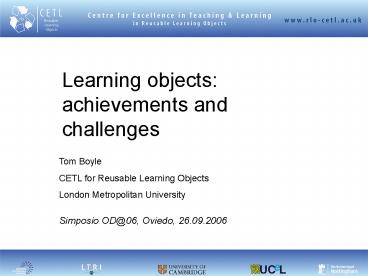Learning objects: achievements and challenges - PowerPoint PPT Presentation
1 / 32
Title:
Learning objects: achievements and challenges
Description:
... Holy Grail of content creation and aggregation in the ... Lego' brick scenario ... How do we create higher order learning objects from these base objects? ... – PowerPoint PPT presentation
Number of Views:59
Avg rating:3.0/5.0
Title: Learning objects: achievements and challenges
1
Learning objects achievements and challenges
Tom Boyle CETL for Reusable Learning
Objects London Metropolitan University Simposio
OD_at_06, Oviedo, 26.09.2006
2
The term Learning Object has become the Holy
Grail of content creation and aggregation in the
computer-mediated learning field. Polsani
(2003)
3
The use of learning objects promises to increase
the effectiveness of learning
Duval et al 2003
4
Themes of talk
- Learning objects main achievements to date
- Significant challenges
- What do we mean by learning objects?
- Better models of composition and decomposition
- Linking learning objects and learning designs
- Questions explored within a three dimensional
model of the learning object space - Work of the CETL for Reusable Learning Objects
- Conclusions
5
Learning Object achievements
- Major achievements in international
specifications and standards - IMS Content Packaging
- IEEE LOM
- SCORM
- Repositories built on these standards
- Universal impact of concept
- Many fine examples of learning objects
6
Packaging and metadata
IMS Package file
Manifest
Metadata Organizations Resources
Manifest
Content
Physical files/content
7
Objects versus learning
- Learning objects as knowledge objects
- packaged
- described
- stored
- retrieved
- Based on international specifications and
standards - Much less emphasis on learning and the design
of effective learning objects - CETL for Reusable Learning Objects places a
strong emphasis on design for effective learning
8
CETL for Reusable Learning Objects
- Started in April 2005 with 3.3 million funding
from HEFCE for the period 2005-2010 - Partners London Metropolitan University,
University of Cambridge, University of Nottingham - Design and develop reusable learning objects
(RLOs) - with a strong pedagogical focus
- Use and evaluate these RLOs with substantial
student cohorts - Extensive staff development and dissemination
programme
9
Some questions
- What are learning objects?
- How do bigger and smaller learning objects
fit together? - What is the relationship between learning
objects and learning designs? - What is the model for reuse is it based on
content or content pedagogical design?
10
The term learning objects has been used with
multiple meanings. We need to clarify the
different meanings used and how they might relate
to each other.
11
Learning objects as granular
- "Learning Objects are a new way of thinking about
learning content. Traditionally, content comes in
a several hour chunk. Learning Objects are much
smaller units of learning, typically ranging from
2 minutes to 15 minutes." (Wisconsin Online
Resource Center) - "A Learning Object is defined as the smallest
independent structural experience that contains
an objective, a learning activity and an
assessment." (L'Allier 1997)
12
Learning objects as anything?
- a learning object is defined as any entity that
may be used for learning, education or
training. IEEE LOM - A Learning Object is an independent and
self-standing unit of learning content that is
predisposed to reuse in multiple instructional
contexts. (Polsani 2003)
13
Mapping the learning object space
The Learning Object Cube - LOC
14
Exploring the LOC space
Def a learning object as any entity that may
be used in learning
. IEEE LOM
15
Learning objects as basic units
the smallest independent structural experience
- the minimum meaningful pedagogical unit
16
Complex or higher order learning objects
Definitions sound as if they are focused on the
bottom left quadrant, but in practice are applied
almost all the way along the aggregation dimension
17
Aggregation models of composition
- Aggregation
- aggregation of assets into learning objects
- aggregation of smaller ones learning objects to
form bigger ones - independent reuse of components
- composition and decomposition
- Lego brick scenario
- But this has little to do with how learning
objects are actually classified and used - There is no adequate pedagogical model. The
aggregation model totally avoids the key issues
of the nature of the learning objects (at each)
level and how they fit together
18
Reusable pedagogical patterns
A micro-context for learning
Extract the reusable learning design the
pedagogical pattern and make it reusable
19
Generative learning objects (GLOs)
- The basis for reuse is the pedagogical pattern
rather than content of the learning object - A richer basis for reuse and repurposing
- This gives a tremendous increase in productivity
- Allows local tutors to repurpose learning objects
to meet their local needs and preferences
20
Some examples of learning objects
21
EASA learning objects
Winner of European Academic Software Award 2004
22
Engage students with familiar every day examples
23
Graphic examples
24
Active student learning
25
Reference for a book
26
Acids and Alkalis
27
Mobile multimedia learning objects
28
Linking learning objects and learning designs
- Generative learning Objects (GLOs)
29
GLOs separate ? design pattern from Concrete
learning object
Challenges
How to elucidate and articulate these
patterns? and How to make the result usable by
tutors?
30
GLO Authoring Tool
31
(No Transcript)
32
Conclusions productive questions
- What are base learning objects?
- How do we create higher order learning objects
from these base objects? - How do we extract and make available reusable
learning designs at this level? - How do we involve tutors as re-users
of content? or (also) as adapters of
reusable pedagogical patterns?































